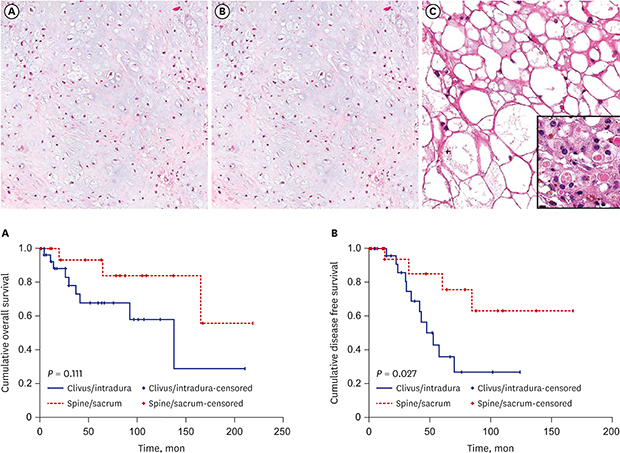1. Louis DN, Ohgaki H, Wiestler OD, Cavenee WK. WHO Classification of Tumours of the Central Nervous System. Geneva: World Health Organization;2016.
2. Walcott BP, Nahed BV, Mohyeldin A, Coumans JV, Kahle KT, Ferreira MJ. Chordoma: current concepts, management, and future directions. Lancet Oncol. 2012; 13(2):e69–e76.

3. Heffelfinger MJ, Dahlin DC, MacCarty CS, Beabout JW. Chordomas and cartilaginous tumors at the skull base. Cancer. 1973; 32(2):410–420.


7. Jian BJ, Bloch OG, Yang I, Han SJ, Aranda D, Parsa AT. A comprehensive analysis of intracranial chordoma and survival: a systematic review. Br J Neurosurg. 2011; 25(4):446–453.

8. Ahmed R, Sheybani A, Menezes AH, Buatti JM, Hitchon PW. Disease outcomes for skull base and spinal chordomas: a single center experience. Clin Neurol Neurosurg. 2015; 130:67–73.


9. Naka T, Boltze C, Kuester D, Samii A, Herold C, Ostertag H, et al. Intralesional fibrous septum in chordoma: a clinicopathologic and immunohistochemical study of 122 lesions. Am J Clin Pathol. 2005; 124(2):288–294.

10. Naka T, Boltze C, Samii A, Herold C, Ostertag H, Iwamoto Y, et al. Skull base and nonskull base chordomas: clinicopathologic and immunohistochemical study with special reference to nuclear pleomorphism and proliferative ability. Cancer. 2003; 98(9):1934–1941.

11. Yamaguchi T, Yamato M, Saotome K. First histologically confirmed case of a classic chordoma arising in a precursor benign notochordal lesion: differential diagnosis of benign and malignant notochordal lesions. Skeletal Radiol. 2002; 31(7):413–418.


12. Kyriakos M. Benign notochordal lesions of the axial skeleton: a review and current appraisal. Skeletal Radiol. 2011; 40(9):1141–1152.


14. Naka T, Boltze C, Kuester D, Samii A, Herold C, Ostertag H, et al. Histogenesis of intralesional fibrous septum in chordoma. Pathol Res Pract. 2005; 201(6):443–447.


15. Jeffrey PB, Biava CG, Davis RL. Chondroid chordoma. A hyalinized chordoma without cartilaginous differentiation. Am J Clin Pathol. 1995; 103(3):271–279.

16. Deshpande V, Nielsen GP, Rosenthal DI, Rosenberg AE. Intraosseous benign notochord cell tumors (BNCT): further evidence supporting a relationship to chordoma. Am J Surg Pathol. 2007; 31(10):1573–1577.


17. Yamaguchi T, Suzuki S, Ishiiwa H, Ueda Y. Intraosseous benign notochordal cell tumours: overlooked precursors of classic chordomas? Histopathology. 2004; 44(6):597–602.


18. Yamaguchi T, Suzuki S, Ishiiwa H, Shimizu K, Ueda Y. Benign notochordal cell tumors: a comparative histological study of benign notochordal cell tumors, classic chordomas, and notochordal vestiges of fetal intervertebral discs. Am J Surg Pathol. 2004; 28(6):756–761.


19. Shen J, Li CD, Yang HL, Lu J, Zou TM, Wang DL, et al. Classic chordoma coexisting with benign notochordal cell rest demonstrating different immunohistological expression patterns of brachyury and galectin-3. J Clin Neurosci. 2011; 18(1):96–99.


20. Nishiguchi T, Mochizuki K, Ohsawa M, Inoue T, Kageyama K, Suzuki A, et al. Differentiating benign notochordal cell tumors from chordomas: radiographic features on MRI, CT, and tomography. AJR Am J Roentgenol. 2011; 196(3):644–650.


21. Adamek D, Malec M, Grabska N, Krygowska-Wajs A, Gałązka K. Ecchordosis physaliphora - a case report and a review of notochord-derived lesions. Neurol Neurochir Pol. 2011; 45(2):169–173.


22. Nishigaya K, Kaneko M, Ohashi Y, Nukui H. Intradural retroclival chordoma without bone involvement: no tumor regrowth 5 years after operation. Case report. J Neurosurg. 1998; 88(4):764–768.

23. Bergmann M, Abdalla Y, Neubauer U, Schildhaus HU, Probst-Cousin S. Primary intradural chordoma: report on three cases and review of the literature. Clin Neuropathol. 2010; 29(3):169–176.


24. Wang L, Wu Z, Tian K, Li G, Zhang J. Clinical and pathological features of intradural retroclival chordoma. World Neurosurg. 2014; 82(5):791–798.















 PDF
PDF Citation
Citation Print
Print




 XML Download
XML Download